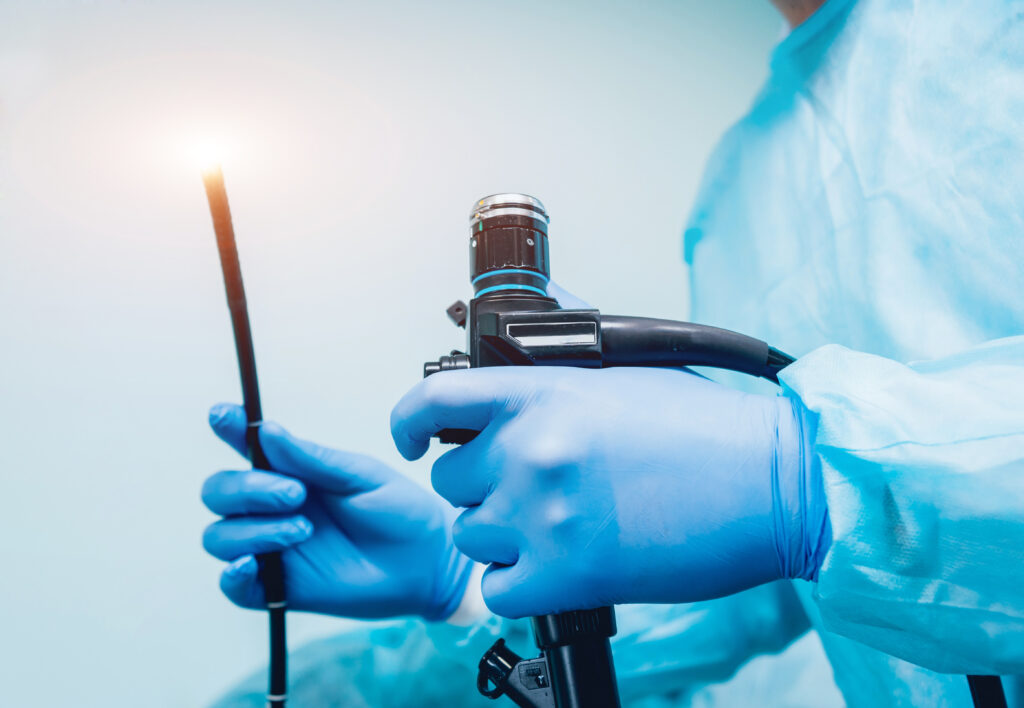Det ser ud til, at du er i USA
Vi har et andet websted (www.q-bital.com), som passer bedre til din placering
NHS Englands medicinske direktør har lagt håndskerne ned for, at sundhedsudbydere kan opnå meget bedre kræftresultater. Der er sat et mål om, at 99 procent af patienterne skal vente mindre end seks uger mellem henvisningen til diagnostisk test og testen finder sted.
Som en nylig Offentlige politiske projekter (OPP) rapport: Ser man indenfor: tilstanden af endoskopi i England, har afsløret, vil disse beundringsværdige mål ikke være opnåelige, medmindre NHS's kapacitet til endoskopi er placeret på et mere sikkert grundlag. Desværre er dette i øjeblikket ikke tilfældet for hospitalsfonde i hele England. Rapporten fandt, at 41 procent af trusts opererer med endoskopi suiter, der nærmer sig eller overstiger producentens anbefalede ti-årige levetid.
Relevansen af denne diskussion er blevet yderligere forstærket af professor Sir Mike Richards, tidligere National Cancer Director for NHS England, nylige rapport med titlen: Den uafhængige gennemgang af voksenscreeningsprogrammer i England. Det er klart, at det aldrig har været mere relevant at have kapacitet til at trække på flere muligheder for at fremme udbredelsen af screeningsprogrammer.
PPP's rapport, udgivet i samarbejde med Vanguard Healthcare Solutions, behandlede dette emne ved en livlig rundbords-arrangement på dette års
IHEEM
Sundhedsejendommes konference. Til stede var adskillige ejendoms- og facilitetsadministratorer sammen med autoriserende ingeniører og kliniske eksperter til dekontaminering og endoskopi fra NHS-trusts i hele Storbritannien. Diskussionen gav et engagerende forum, hvor disse senior tankeledere talte om, hvorfor forringelse af endoskopifaciliteter har fået lov til at manifestere sig så alvorligt på tværs af NHS.

Ifølge PPP's rapport er 25 procent af de dekontamineringssuiter, der i øjeblikket er i brug i hele England, over 10 år gamle, og 15 procent af hospitalerne har ikke opgraderet deres suiter i de seneste otte år. I sammenhæng med den skyhøje efterspørgsel efter endoskopi-udbud, er der helt klart behov for større undersøgelse af, præcis hvordan vi definerer livscyklussen for en endoskopi-suite. Dette punkt viste sig at være en væsentlig drivkraft for diskussion.
"Efterspørgslen efter endoskopitjenester går kun i én retning," sagde David Cole, CEO for Vanguard Healthcare Solutions. Som formand for diskussionen var David ivrig efter at undersøge den offentlige sektors deltagere om emnet endoskopi livscyklusser. David stillede spørgsmålet: "I betragtning af denne uundgåelige stigning i aktivitet, hvordan måles den nuværende forventede levetid for endoskopiudstyr?"
Konsensus for mødet var, at endoskopienhedens livscyklusser er baseret på en tidsperiode, hvor udstyret er i aktiv drift, snarere end i henhold til antallet af operationelle cyklusser. I betragtning af stigende efterspørgsel er det ikke længere tilstrækkeligt at måle livscyklusser i år til at sikre, at udstyr kan opnå minimumsstandarderne for dekontaminering på en ensartet dag-til-dag-ud-basis.
Endvidere undlader måling af endoskopi-livscyklusser i aktive år at tage højde for eskalerede vedligeholdelsesomkostninger, som er en uundgåelig konsekvens af stigende brug. Indbygget kapacitet til vedligeholdelse er en luksus, som få truster har råd til i dag, og derfor er en indvirkning på operationelle aktivitetsniveauer uundgåelig.
"Det vigtigste er, hvordan vi øger eksisterende ejendomskapacitet." Alex Chilvers, administrerende direktør hos 18 Week Support "Selvfølgelig vil stigende brug have en skadelig effekt på udstyrets levetid," sagde Alex Chilvers, administrerende direktør hos 18 Week Support, en organisation dedikeret til at hjælpe truster med at administrere henvisninger til behandlingsveje og -mål. Alex insisterede på, at i forbindelse med et fravær af kapitalfinansiering til langsigtede opgraderinger af endoskopisuiter, "det vigtigste er, hvordan vi øger eksisterende ejendomskapacitet."
Man kan se til andre industrier for eksempler på, hvordan man overvåger endoskopiudstyrets levetid. Dette er faktisk en pointe, som Rosemary Jenssen, Healthcare Architect, var ivrig efter at komme med. "Biler har intelligente serviceintervaller baseret på deres aktivitet, mens endoskopienheder ser ud til at blive overvåget baseret på det antal år, de har været aktive," sagde Rosemary. "Hvis vores cyklusovervågning var baseret på mere direkte brug af udstyr, ville du have meget bedre muligheder for fremadrettet planlægning til at give information om, hvornår det overbrugte udstyr skal udskiftes."
Når udstyr begynder at svigte, er det for sent, og som Rosemary klogt bemærkede, må NHS se efter at geare sin cyklusovervågning til en mere aktivitetscentreret tilgang. Rosemary var ikke den eneste, der fremhævede dette. Cliff Howell, tidligere direktør og operationel leder for NHS Estates and Facilities, Efficiency and Productivity Division hos NHS Improvement, påpegede i skarpe vendinger: "Vi skal skifte til en evidensbaseret tilgang i stedet for blot at læse, hvad reparationsmanualen siger."
Hvis facility managers fra hele NHS trusts anerkender begrænsninger i, hvordan den kritiske infrastruktur inden for endoskopi suites levetid overvåges, er det vigtigt at vide, hvad der får en trust til at erstatte eller i det mindste udvide sine eksisterende faciliteter.
Hurtige svar udeblev, da facility managers straks citerede bredere bekymringer omkring her-og-nu-tænkning, hvilket ofte forhindrer NHS i at træffe desperat tiltrængte langsigtede beslutninger vedrørende sin ejendom. En delegeret gik så langt som til at sige, at NHS lider af et "kortsigtet planlægningssyndrom", når det kommer til ejendomsudnyttelse.
I sidste ende, mens truster ønsker at centrere beslutninger omkring opdatering af endoskopiudstyr, er facility managers normalt begrænset af det samme problem – omkostninger. Spørgsmålet om kapitaludgifter og dets skadelige virkning på patientpleje er helt sikkert blevet sat i spidsen for diskussioner om forbedring af sundhedsvæsenet. Økonomiske restriktioner dikterer stadig meget af den daglige beslutningstagning for godser og anlægsforvaltere. For alt for mange handler det stadig om pengene.
Hvad er triggerne for, at en trust gennemgår og potentielt opgraderer sine endoskopifaciliteter? Hvad er virksomhedens versus den individuelle risiko? Hvilke foranstaltninger kan en trust tage for at skabe opmærksomhed om forældet endoskopiudstyr? Det er den type spørgsmål, som facility managers på tværs af NHS bør overveje, men gang på gang er deres beslutninger baseret på for mange konkurrerende prioriteter.

For at fremme et mere proaktivt miljø, hvor beslutninger er baseret på patientsikkerhed, er det vigtigt, at kapitalstrømmen direkte til endoskopiservicefaciliteter finder sted. Nuværende fejl i at sikre økonomisk støtte til endoskopi afslører en afbrydelse mellem et ønske på nationalt politisk niveau om at adressere mål for kræftscreening og det udstyr, der så ofte kan vise sig at være afgørende for at nå disse mål.
"På samme måde som LINAC og udskiftning af billedbehandlingsudstyr er der ofte initiativer og midler på nationalt plan til rådighed for at erstatte gammelt og forældet udstyr," sagde Cliff, som foreslog, at denne politik bør udvides til at omfatte udstyr til endoskopitjenester.
På trods af et mindre klart investeringsbillede er der muligheder for truster for at sikre, at de vedligeholder deres endoskopifaciliteter og derfor opfylder målene for kræftscreening. "Backlog ejendomme og udstyrsudskiftning i NHS er på et rekordhøjt niveau, mens kapitaltilgængeligheden forbliver begrænset. Efterslæbet vil derfor stadig stige,” sagde Cliff. "Måske bør NHS overveje at afgrænse livscyklusfinansiering til fremtidige udviklinger for at forhindre en gentagelse af fortiden."
Forøgelse af eksisterende ejendomskapacitet vil spille en stadig vigtigere rolle. Professor Richards' rapport for NHS England citerede mobile enheder som potentielt afhjælpende belastninger på endoskopitjenester. Dette har fordelen ved at overvinde de indvendinger, som klinikere citerer om brugen af offsite faciliteter som en trussel mod fælles sundhedsydelser.
For at ambitiøse kræftmål kan nås, skal forandringen komme et eller andet sted fra. PPP-rapporten afslørede, at 87 procent af hospitaler, der har rapporteret ældende dekontamineringssuiter (dvs. dem, der ikke har været genstand for renovering i de sidste otte år) også er en del af truster, der ikke nåede seks ugers ventemål for diagnostisk test.
"Storbritannien har nogle af de højeste standarder for dekontaminering og sterilisering overalt i verden." David Cole , administrerende direktør for Vanguard Healthcare Solutions
Endoskopienheder på tværs af NHS er kommet langt fra de "kosteskabe", der engang blev brugt (som en delegeret beskrev dem) til de store, sofistikerede, centraliserede enheder, men som David Cole påpegede, må dette ikke undskylde selvtilfredshed. "Storbritannien har nogle af de højeste standarder for dekontaminering og sterilisering overalt i verden," sagde David, da han afsluttede det, der var en engagerende og livlig diskussion, "men vi kan ikke tillade os selv at gå bagud."
Mens vi afventer nationale politiske beslutningstagere til at rette hårdt tiltrængt kapitalfinansiering til frontlinjen, skal akutte truster sikre, at endoskopiservicefaciliteter ikke efterlades, og at patienterne ikke begynder at mærke negative effekter.



Vanguard Healthcare Solutions
Unit 1144 Regent Court, The Square, Gloucester Business Park, Gloucester, GL3 4AD

Vi har et andet websted (www.q-bital.com), som passer bedre til din placering